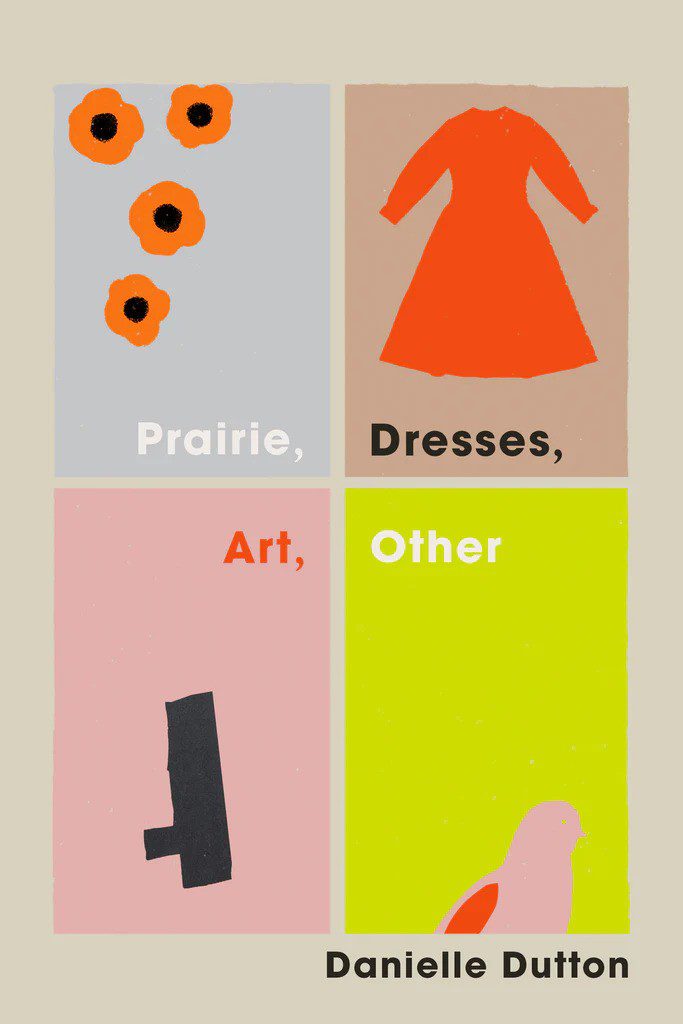Founder of the feminist press Dorothy, a publishing project, and author of six books, Danielle Dutton has an ear for unordinary literary forms. SPRAWL,her self-described “novel of the suburbs,” follows an unnamed narrator through her day-to-day life, gleaning ekphrastic momentum from the still life photographs of Laura Letinsky. Margaret the First, a fictional biography of the life of Margaret Cavendish, blends quotations from Cavendish’s writing so seamlessly into the fabric of the novel that her quotations and Dutton’s elaborations become indistinguishable. Her most stylistically freewheeling endeavor to date, Prairie, Dresses, Art, Other (Coffee House Press, 2024),takes her digression from stylistic norms to a new extreme.
Broken into four eponymous parts, the book begins with “Prairie,” a section that reads like a series of faintly connected short stories. All of the narratives feel somewhat autobiographical, tied to the perspective of a woman navigating life in the Midwestern prairie. In lonely domestic scenes of dependency gone awry, something essential is always absent, and the void created by this gnawing lack haunts the narrative.
In one story, a woman sits by a river and waits for her male companion to return from his walk. Hours pass, he hasn’t returned. Anxiously attuned to her surroundings, she “hears the shushing of the river as it pushes past fallen branches, and even the sound the sand makes as it sparkles and suddenly crumbles under the weight of a bee.” A truck pulls into the parking lot behind her, driven by a man on his own. Suddenly she’s fleeing, swimming across the river with her bag held over her head, wondering if it’s she who is lost or her friend.
Flooded with mythological breath, this section often dips into the surreal, stitching together recurring dreams, real and imagined botanical terms, and dialogue from novels and films to create a tapestry of the desolation of modern life and the flimsiness of our protections against environmental collapse. Hypnotically connected to the prairie, the women in these stories —though they could easily be the same woman—are distinctly not hysterical yet are threaded with a constant fear of masculine violence.
“Dresses” takes a hairpin turn from the fiction-adjacent and therefore more comfortable narrative structure of the preceding section. She lists “Sixty-six dresses I have read,”a collection of fashion trends in major works of literature. Perhaps for cult followers of Dutton’s work, this section provides insight into how her taste in literature has informed herparticular flair and style. But the demand on the reader to interpret Dutton’s curation feels too great a task. We are left fumbling to connect this list to the book as whole, beyond vaguely associating it with the overarching feminist themes. Later, Dutton addresses her choice to write so obliquely:
Is it wrong to want to write toward what isn’t intended to be read? What I want is a story that’s an object that can turn itself inside out. So perhaps what I’m thinking of as inspiration is something else instead.
“Dresses” sets a tone for the book, that this is fundamentally a collection of Dutton’s thoughts and inspirations, and any attempt we may make to justify or explain the presence of one thing over the other is ill-advised, a futile pursuit. She is experimenting, fiddling with her inspirations and turning them inside out, and we may watch them fold and turn but should not attempt to intervene.
As we make our way through the book, it becomes clear that Dutton is attempting a remodulation on the very idea of self-examination. In “Art,” she uses examples of other authors’ ekphrastic works to circle around her own drive to write, and in doing so she slowly constructs a manual on how to read her work:
It seems to me that ekphrastic writing, at least the kind I’m interested in, takes place as a dialectic between these two impulses, between art’s ability to make strange what has grown familiar and translation’s desire to make recognizable the experience of one artwork inside the space of another.
Dutton views ekphrasis as a kind of translation—something that unavoidably impacts the original work in the process of interpretation. While considering the ethics of this often-nonconsensual collaboration, she analyzes the multilayered “ekphrasis-as-commentary” of John Keene’s writing on Edgar Degas as well as Rindy Sam’s stain on Cy Twombly’s white canvas (her scandalous lipsticked smooch), among many others. She’s interested in how a writer might attempt to “replace paintings with language” or merge text and image. The inspired piece never fully represents the original work but instead leaves behind something new and precious, a fresh way to view the original.
The end of the book returns to Dutton’s signature autofiction. Amid the guise of stories, Dutton considers the slipperiness of realism, where the border between the self and the other are mirrored. This is most allegorized by “Double Room,” in which Dutton’s intent is to demonstrate how a writer is always writing under the influence of another and therefore “a story is always two, one hidden inside the other.” With each analytical consideration of these pieces, Dutton removes the shell of her own influences until, like a set of Matryoshka dolls, we finally discover the prime motivator in all of her writing: herself, the reader.
One might assume that such indebted writing would feel impersonal by the nature of it not being at any point entirely her own, yet her work gains power from this knack for collage. She is a magpie of feminist literature; she gathers glittering fragments from all kinds of art—photographs, novels, paintings, essays, and poems—and intertwines them into a nest of feminine themes. The stories she tells are profoundly intimate yet universal, with themes of self-doubt, irredeemable nostalgia, and uneasy nuclear families. In her hands, these themes become her own. Her strength lies in her ability to weave a multilayered, universal experience out of the materials of so many before her, recycling others’ work to create something new.




